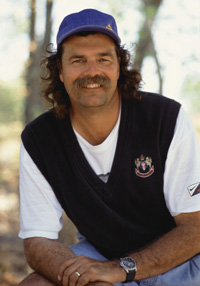Source: Thepilot.com
Author: Howard Ward
 He was a commanding figure. He wore his hair long, his mustache bushy, and he was a big guy, ruggedly handsome.
He was a commanding figure. He wore his hair long, his mustache bushy, and he was a big guy, ruggedly handsome.
Mike Strantz didn’t look like a man who would go easily, and he didn’t. He fought the cancer with the same determination that he approached a property that dared him to build a golf course on it.
I was fortunate enough to do two interviews with Strantz, shortly after the opening of Tobacco Road in Sanford, one of his architectural triumphs, and again while he was applying the finishing touches to Tot Hill, an amazing course laid out on a challenging piece of land in Asheboro.
Both of those golf courses tell you a lot about Mike Strantz, the golf course designer. But his widow, the lovely Heidi, can tell you a lot more about Mike Strantz, the husband and father of two beautiful daughters.
Heidi Strantz talked about her late husband and the love of her life during a meeting of the Carolinas Golf Reporters and the South Carolina Golf Ratings Panel last weekend at Seabrook Island Resort, and it was both inspirational and moving.
“I thought I was marrying a golf course superintendent when I married Mike,” she recalled. “He had just graduated from the turfgrass school at Michigan, and we thought he would make a career of that.”
Mike definitely knew how to make grass grow, and he enjoyed working the land. He was on the scene at Inverness during the 1979 U.S. Open when Lon Hinkle found a way to cut a dogleg on one hole and the decision was made to plant a tree in the opening overnight. Strantz is shown in a picture as the tree is being planted.
Strantz began his design career under the tutelage of the renowned Tom Fazio, spending 10 years with that genius.
“He started at the very bottom,” Heidi said, “and worked long hours, much of the time away from home. Finally, he said, ‘I can’t do this anymore.’ It wasn’t easy, but eventually the golf world found Mike.”
A call from Larry Young, a developer in Myrtle Beach, resulted in Strantz designing Caledonia and True Blue, two courses that thrust him into the forefront as one of America’s brightest young architects.
Once he was on his own, Strantz developed a reputation for working on courses as close to his home in Charleston, S.C., as possible. He worked on only one course at a time, devoting himself to that project until it was completed.
“Mike was an artist,” Heidi said, demonstrating this by showing some slides of his artwork. “He took his art and translated it to the courses. It was a combination of his art and his love of the land.
“Mike made everybody feel special. He had been at the bottom, and he knew how it felt to have no one pay attention to you. He didn’t look down on anyone, and that’s why the men working for him loved him. That’s how those great golf courses got built.”
Strantz built only nine courses before his untimely death.
“He had tongue cancer,” Heidi said, “and it was the kind that early detection could have cured. But Mike was too busy working and didn’t take time to have it checked. Most of his tongue had to be removed, and he wasn’t able to express himself with words. When he had to talk to someone, he used me as an interpreter, because I could understand every word he said. I had to go to meetings with him, and he’d say, ‘You have to tell them what I’m going to say.’
“Mike got a lot of criticism for building hard golf courses, but he was a purist. Everybody said, ‘Mike Strantz doesn’t know how to draw a straight line,’ but his visions came true.”
Tobacco Road is a prime example of the visions Strantz saw. He looked at a piece of land that had been ravaged over the years as a quarry and saw a one-of-a-kind golf course. A piece of property that could have been used as nothing else is now one of the most talked about golf courses in the country. It’s on the bucket list of golfers all over the world.

Leave A Comment
You must be logged in to post a comment.